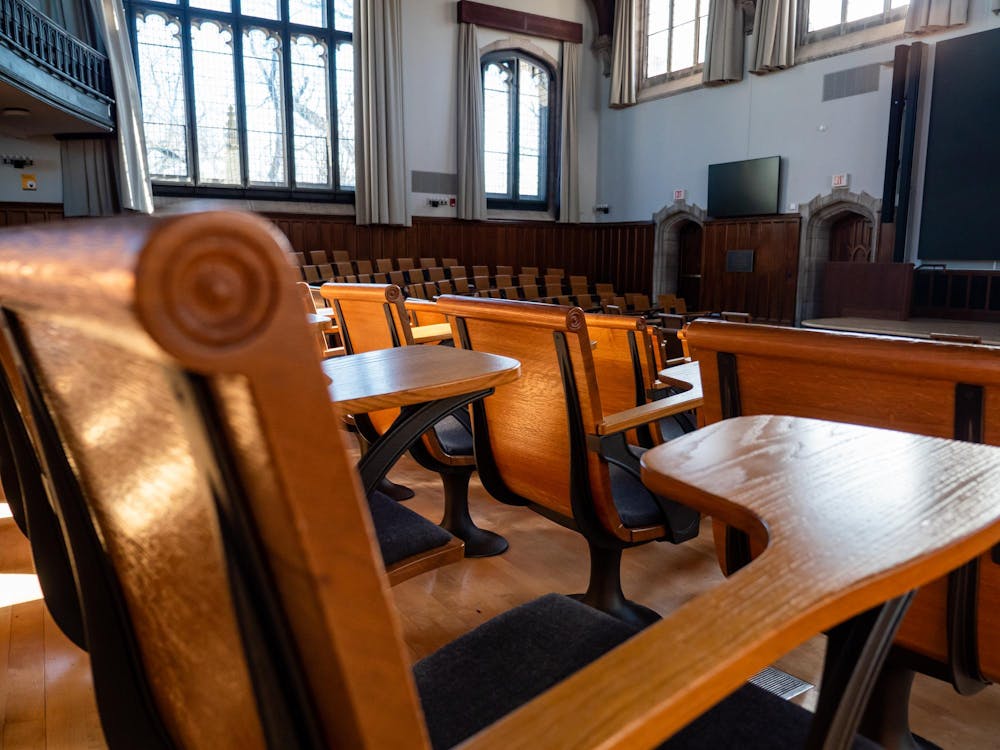After her term as USG president ended, Myesha Jemison ’18 continued looking for ways she could shape the evolution of the University. Now, Jemison will contribute to that evolution as a Young Alumni Trustee on the Board of Trustees.
Jemison is one of six new trustees recently elected to the board. She is joined by Joshua Bolten ’76, Kimberly Johnson ’95, Marco Tablada ’93, Kirsten Bibbins-Domingo ’87, and Craig Robinson ’83.
For Jemison, taking on both the USG presidency and a place on the Board of Trustees come in the same goal: making impactful change at the University.
“What really inspired me to move from USG to trustee work was a desire to have a stronger impact on what was happening at the University and to guide University initiatives and think more specifically about the future,” Jemison said.
As much as her role is expanding in terms of scope, Jemison emphasized she did not want to lose the approachability she felt she offered while serving as the USG president. She said she wants to help combat the perception that the trustees have a distant relationship to the student body.
“I would love for people to email me about things that the University could be doing better,” Jemison said. “I’ll also be thinking about that myself and be reaching out to other people so that I don’t just think about this job from my own experience but from what others are thinking.”
The role of Young Alumni Trustee differs from the other trustee positions in terms of the election process. Months prior to the election, the Office of Alumni Affairs invites all seniors to attend a meeting to learn about what the position entails. If they are interested, the senior can get on the primary ballot by gathering 50 signatures from fellow seniors, and submitting a petition.
According to Robert Durkee ’69, Vice President and Secretary of the University, there are typically around 20 candidates in any given year's primary. The senior class then ranks the candidates to determine the three finalists. In the general election, the current juniors, seniors, and the two most recent graduating classes then decide which of the three will be on the board for a four-year term.
The other three types of trustees on the board are alumni trustees, who are elected by the alumni body as a whole and serve four-year terms, and charter and term trustees, who are elected by the board and serve eight- and four-year terms, respectively.
The latest board sees the addition of three new term trustees, Bolten, Johnson, and Tablada, and two new alumni trustees, Bibbins-Domingo and Robinson.
The election process differs greatly for each category of trustee, but Durkee said that once a trustee is on the board they all have the same standing. All share the same authority and responsibility in decisions concerning the future of the University, from the most recent graduates to the oldest alumni.
“There’s no differentiation once elected in terms of which process brought you to the board,” Durkee said. “They all have the same rights, responsibilities, and duties.”

Bibbins-Domingo had never considered trusteeship, but when approached by the committee, she was more than willing to put her name on the ballot. She expressed surprise and gratitude for the opportunity to serve.
“It’s both a critically important time for institutions like Princeton when you think about training our leaders for the future,” Bibbins-Domingo said. “It’s a very interesting time to help Princeton to continue to chart its course.”
Bibbins-Domingo plans to draws from her experiences in academia as the Lee Goldman M.D. Endowed Chair in Medicine and professor and chair of epidemiology and biostatistics at the UC San Francisco. She also serves as the inaugural vice dean for population health and health equity in the UCSF School of Medicine.
Bolten, a new term trustee, also brings academic experience to the table, having spent two years as a visiting professor at the Woodrow Wilson School. He also brings extensive experience in the world of public policy, serving in the White House under President George W. Bush as chief of staff, director of the Office of Management and Budget, and deputy chief of staff for policy.
“There are a lot of challenges for America’s great Universities in the current environment, but also a lot of opportunities,” Bolten said. “I’m guessing what I’ll find on the board is that the movement of both our society and our education into an ever-more digital age poses the largest number of challenges and opportunities.”
Johnson, another term trustee, comes from a strong corporate background. She is the executive vice president and chief operating officer of Fannie Mae, the Federal National Mortgage Association, and a member of Fannie Mae’s management committee. She is also a director of the board of Calvert Impact Capital.
“The overall climate at the University has certainly changed since I was there in the 90s, but I’m really excited about the way that the University has expanded and advanced,” Johnson said. “I’m really excited about getting the opportunity to serve.”
The final newest members of the board are Robinson, vice president of player development and G League operations for the New York Knicks and a former professional basketball player himself; and Tablada, the founder and managing partner of Wiborg Capital LLC and former managing director, portfolio manager, and member of the management committee of Lone Pine Capital LLC. Neither had responded to request for comment at the time of publication.
To Durkee, this particular cohort of new trustees is remarkably diverse in terms of when they attended the University, with one graduate from the ’70s, two from the ’80s, two from the ’90s, and one from the most recent graduating class. He said he believes their individual knowledge and backgrounds make them well-equipped for the collective effort of supporting the University’s core values.
“[The trustees are] making sure there’s a range of professions, backgrounds, experiences, and viewpoints — a diversity of people,” Durkee said.
Bolten and Jemison both expressed their eagerness to work with the group, knowing that their differences in experience make them all the more capable to achieve the goals they have in common.
“Everybody comes in with a great affection and commitment to the University,” Bolten said. “We bring a wide variety of perspectives, which I admire about the composition of the board, and I’m looking forward to the opportunity to participate in that diverse group toward the common goal of making sure the University remains the premier place that it is.”
Jemison praised the diversity of the board specifically for more closely representing what the University looks like now. In light of historical changes ranging from coeducation to the addition of people of color, Jemison said she has a responsibility to demonstrate how the University will be known and understood.
“In terms of my role, I think it’s being mindful of how we define the University and who we see as being a part of the University, who we see as being a ‘Princetonian,’” Jemison said.
The new trustees began their terms July 1.








